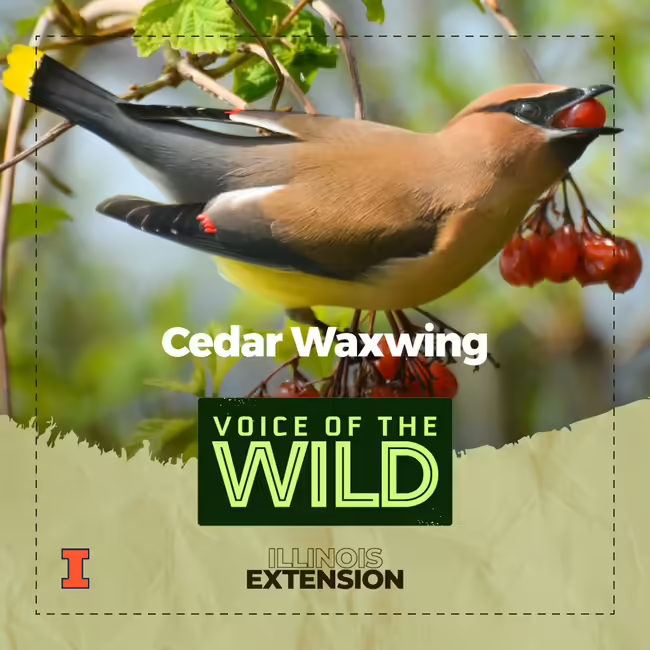
Episode Number
26
Episode Show Notes / Description
Cedar Waxwing (Bombycilla cedrorum).
The Cedar Waxwing’s high-pitched call is often heard coming from hungry flocks visiting a local stand of fruit-bearing trees. Look out for their crisp black mask, strong yellow stripe at the end of their tail, and their courtship display of passing a berry back and forth!
Do you want to learn more bird songs, frog calls, and insect noises? Join Voice of the Wild every Friday to explore a new wild voice. We’re available on most podcast platforms, including Apple Podcasts, Spotify, and YouTube.
Subscription links Here
Subscribe to the Newsletter
Listen online on our Homepage
The following Cornell Lab | Macaulay Library recordings were used in this episode:
Cedar Waxwing song by Wil Hershberger (ML508854)
Cedar Waxwing staccato song by Sally F. Hoyt (ML508857)
Cedar Waxwing flock call by Geoffrey A. Keller (ML508855)
Sources and more:
- https://www.audubon.org/field-guide/bird/cedar-waxwing
- https://www.allaboutbirds.org/guide/cedar_waxwing/overview
- Sibley, David. Sibley Birds East: Field Guide to Birds of Eastern North America. Second edition. New York: Alfred A. Knopf, 2016. Print.
- Godfrey, Michael A, John Farrand, and Roger Tory Peterson. Videoguide to the Birds of North America. New York, N.Y: MasterVision, 1985. Film.
Transcript
This is Illinois Extension’s Voice of the Wild. A new wild voice in just a moment, so find someplace quiet, take a deep breath, and enjoy.
Heard alone, this high pitched call could be easy to miss, but the bird that makes it is quite social so its nearly always heard as one part of a larger soprano chorus. A roaming flock takes a diet of insects, fruit, fruit, and more fruit. Its one of the most frugivorous birds in illinois. Its courtship display is famously cute, with the male and female passing a berry back and forth, occasionally with a little hop. While they have a crisp black mask and a strong yellow stripe at the end of their tail, the rest of their plumage is a subtle mix of yellow, brown, and gray. Look for them in scrubby areas with lots of Eastern Red Cedars or in neighborhoods with plenty of fruit-bearing trees.
This is the cedar waxwing (Bombycilla cedrorum) from the family Bombycillidae. While the cedar waxwing often sings smoothly, it can also sing with a staccato trill. Here’s the cedar waxwing again, first with a strong trill and then with the smoother calls.
Thank you to the Macaulay library at the Cornell lab for our bird sounds. And thank you for tuning in to learn a new wild voice with Illinois Extension.
Heard alone, this high pitched call could be easy to miss, but the bird that makes it is quite social so its nearly always heard as one part of a larger soprano chorus. A roaming flock takes a diet of insects, fruit, fruit, and more fruit. Its one of the most frugivorous birds in illinois. Its courtship display is famously cute, with the male and female passing a berry back and forth, occasionally with a little hop. While they have a crisp black mask and a strong yellow stripe at the end of their tail, the rest of their plumage is a subtle mix of yellow, brown, and gray. Look for them in scrubby areas with lots of Eastern Red Cedars or in neighborhoods with plenty of fruit-bearing trees.
This is the cedar waxwing (Bombycilla cedrorum) from the family Bombycillidae. While the cedar waxwing often sings smoothly, it can also sing with a staccato trill. Here’s the cedar waxwing again, first with a strong trill and then with the smoother calls.
Thank you to the Macaulay library at the Cornell lab for our bird sounds. And thank you for tuning in to learn a new wild voice with Illinois Extension.